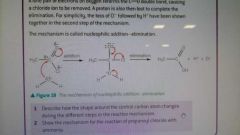![]()
![]()
![]()
Use LEFT and RIGHT arrow keys to navigate between flashcards;
Use UP and DOWN arrow keys to flip the card;
H to show hint;
A reads text to speech;
4 Cards in this Set
- Front
- Back
|
How is an Acid Anhydride formed? |
Formed by the removal of water from two Carboxylic acid molecules
2Carboxylic acid molecules -> acid anhydride + water |
|
|
Acid anhydride + phenol -> ? |
Phenyl ester + Carboxylic acid Less reactive than acyl anhydrides, useful for lab reactions where acyl chlorides may be too reactive
Ethanoic anhydride + phenol -> phenyl ethanoate + ethanoic acid |
|
|
Draw and describe the 2-step mechanism of ethanoyl chloride and a nucleophile (e.g. water). Include the name of mechanism. Explain what happens to electron pairs and the C=O bond. |

1. Addition Lone pair of electrons from nucleophile attracted to and donated to +ve Carbon atom of acyl chloride - dative covalent bond formed between nucleophile and carbon atom. C=O bond breaks, forms -vly charged intermediate
2. Elimination Lone pair of electrons in oxygen reform the C=O, causing a chloride ion to be removed. A proton is then lost to complete elimination.
Name: Nucleophilic addition-elimination
|
|
|
Carboxylic acid, acyl chloride and acid anhydride. List in increasing order of reactvity |
Carboxylic acid, acid anhydride, acyl chloride |

